Caring with clear leadership since 1999
- Wilbur's Diary
- Which Pup?
- Home Setup
- Equipment
- Pup Arrives
- Training -Tips
- Socialisation
- Growing Up
- Diet & Health
- Problems
- tab 11
- tab 12
- tab 13
- tab 14
- tab 15
- tab 16
- tab 17
- tab 18
- tab 19
- tab 20
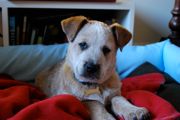
Complete with all our successes, mistakes and observation I would like it to become an aid for the new puppy owner to building a happy healthy pet dog that is a loved member of the family.
The first 18 weeks of a dogs life is the most important time for developing the dog's behaviours. (if you have a working breed like a Kelpie or a Blue Heeler it is 15 weeks!)
Get it right and the dog learns so quickly it is amazing. They are like a sponge absorbing all that is going on around them. I have been to many workshops with world famous animal behaviourists and trainers like Ian Dunbar, Jean Donaldson, Donna Duford and Patricia McConnell and their message is clear- A well trained puppy builds a fabulously trained dog.
Often I am called in when the puppy is 6-12 months of age and has started to develop into a fully grown dog. Suddenly that funny 'Puppy Behaviour' isn't so cute and the owner has a huge job to retrain the dog to become a well mannered pet dog that is a joy to have around. It can be done but it just takes more work.
If you are going to get a dog or know somebody who is please download Dr Ian Dunbar's free book and prepare yourself before the dog arrives home.
When our old dog Mildred passed away we were devastated. So we decided to check the local pounds around the state. A good website to find Pound Dogs is the RSPCA Adopt A Pet.
After checking out the country pounds around NSW, which I found to be generally very well run and the staff very helpful in explaining the behaviors and problems the dog’s may have.
Although we were planning to get a mature dog, I heard that Debbie was having a litter of puppies.
The Breeder
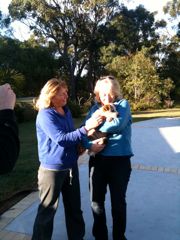
Responsible breeders are usually only too happy to let you visit the kennels and meet the parents.
Buying a puppy from a pet shop or on the internet without knowing the pup's background makes it harder to predict your pup's characteristics.
Unfortunately, there are puppy farms who breed dogs intensively. These breeder's should be avoided because their pup's can have behavioural and health issues.
The Parents
If you can meet both the parents. Here is Missie and Roly and as you can see both are happy, chilled out dogs.
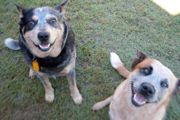
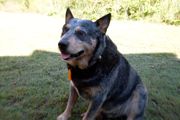
The mum Missie is a family dog and very well mannered and the father Roly is also a very relaxed family dog.
Dog's inherit a lot of their basic traits from their parents and it will give you a good indication of the future temperament of their offspring.
Because they are cattle dogs we didn't wanting a boisterous, nippy pup.
Be wary if either parent is nervous, hyper or stressed and ask yourself honestly if these are the characteristics you would like in your dog.
If you are rescuing a dog from the pound talk to the staff about the dog's temperament and history. They will give you honest and valuable information about your future pup.
Choosing from the litter
Keep in touch with the breeder about your pup's progress and development. It is fun and will build your confidence about the pups.
Each pup will be different and so look for the characteristics you would like in your dog. Rattle your keys and see if the puppy bounces over to investigate or sits back and observes, these are all indicators of the pups temperament but are by no means definitive.
Wilbur was easy going and independent and wanted to be with people. We liked that.
He also liked his food and so was named after the pig in the movie Charlotte’s Web!
However, he was happy to share with his sister.
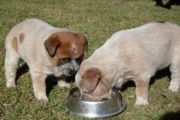
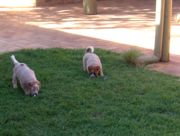
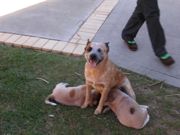
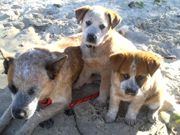
Get your house ready for the pup
Decide where you want the puppy to live, inside or outside, are there places where the puppy is not allowed to go.
Set the rules up from the start and organise the house so the puppy can never make a mistake.
Writing the rules on the fridge is a good way to help everybody treat the pup the same way.
Consistency is the key.

Child proof gates are great for restricting access around the house. Make sure the locking mechanism is easy to open and close with one hand.
If you build a barrier make sure it isn't inconvenient for the rest of the household.
We wanted to keep Wilbur in our main family room with polished floors so if he accidentally went to the toilet it would be easy to clean up.

Smelly things like shoes, socks and other unmentionables are all fascinating to a curious young dog.
Here we used a garden cooler box for easy access to shoes we use.


Thinking ahead can avoid damage, I know of one pup who destroyed a $4000 watering system in an afternoon.

We wanted Wilbur to go to the toilet on the lawn and so that is why we used turf.
He could relieve himself if he was restricted around the house. We could move it inside into his puppy pen at night if needed.
I am not a big fan of artificial materials like Puppy Pads or AstroTurf because they can be mistaken for other objects later on, like magazines or carpet.
Sleeping quarters


It is also handy when visiting friends or new places.


A trampoline bed is also cool for hot summer days, won’t get smelly, harbour fleas and is easy to keep clean.
Wilbur's bed here is under the eaves of the house so he has some protection from the elements.
Wilbur will eventually spend a lot of time outside in the garden so we also have an all weather kennel. We have positioned it so that it is under cover and is shady in the heat of summer. A bowl of fresh, clean water is always nearby. Notice that the dish is nice and heavy so he can’t knock it over.
Dog Toys- The easy entertainers
You will also need to have toy’s to keep the puppy busy. Puppies chew a LOT and so good solid chew toys, ropes and squeakies will help keep them occupied and out of trouble. Putting dinner in a chew toy can keep the pup occupied if you are leaving him in a pen or a crate. We still feed Wilbur out of a Kong Toy because he is quite a greedy eater.




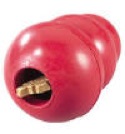
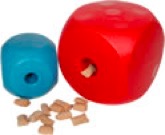
Many problems arise when the dog is bored and good toys can keep them occupied. Some toys might seem expensive, however a good toy will be durable and will seem cheap next to a chewed couch!
I look for a solid toy especially if you have a chewer. I prefer rubber toys because if a piece is chewed off it passes through the dogs gut more easily than plastic or string.
Bounce adds a lot more fun for the dog and can be used in the park if they like to chase things. Be careful that while the pup’s bones are developing they don’t leap,twist or jump too much. They can easily damaged their growing bodies.
Squeaky toys are great for some dogs but others will destroy them in seconds (including our dog Mildred). Squeakies are great for getting the pups attention when there are distractions around. Like being in the park.
Soft Toys
We chose a number of soft toys for Wilbur. Some Toys he played with for many months without damaging. However, others he destroyed in a matter of minutes.

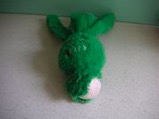

The common element I have noticed is that if they are soft all over he tends to be more gentle with them. His green flea has lasted since he was a little puppy.
Toys that are both soft and hard, like the Wubba, he tended to want to dissect straightaway. When the puppy is teething they want to gnaw on firmer objects.
Dragon was quite soft in the body however you can see on his nose Wilbur pulled it apart and pulled the stuffing out. The nose was the firmest part of the toy.
We pulled the rest of the stuffing out so he he wouldn’t ingest the soft fibrous material. The toy was now completely floppy, Wilbur treasured his new floppy dragon and stopped pull it apart.
Soft toys can be very expensive, choose the toy’s wisely and you will save yourself a lot of money. Wilbur’s Flea is the winner in the durability stakes.
My wife sue got sick of me repeating this mantra but I wanted Wilbur to be treated like an adult right from day 1. This way his role was clear and he wouldn’t get stressed because the rules changed as he got bigger.
Puppy arrives home-
We had a 10 hour drive home when we picked Wilbur up from Debbie in Yamba. This seemed like a huge trip but was an absolute blessing because it allowed Wilbur to fall asleep and wake up with us many times throughout the day.
We stopped every couple of hours had a toilet stop, play and training with treats. We also met several new people.
By the time we arrived at home we were old mates.
Toilet Training - Number 1 Priority

Now you can take the puppy to meet the new family and explore the home.
Puppies have small bladder’s and so will need to relieve themselves every hour or so and after sleep. Take them to the designated toilet spot regularly, praise and reward when the pup eliminates. Wilbur now eliminates on command because Debbie and us instilled this behaviour pattern clearly on him.
If you see your pup about to go to the toilet in the wrong place, pick them up straight away and run them straight to your toilet spot. Praise and Reward on success.
Mistakes do happen and if it happens blame yourself for not paying attention and clean up the mess. Do not use cleansers with strong scents or ammonia, it can smell like another dog and could lead to further marking behaviour.
Try and avoid that area till the odour has dissipated.
Meeting the family

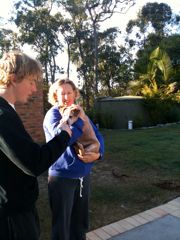
Everybody will be excited to meet the new puppy because they are so soft and cuddly. Be careful not to overwhelm the pup on day one. Meet all the family one by one and keep the excitement levels contained.
Generally, a new puppy arrives on a weekend. A day when the family routine is different to a week day. If you can try and think of what the puppy’s day will be like during the main part of the week and get the puppy used to that routine.
If the puppy will be alone, give him a few time outs over the weekend and come and go several times even for just a couple of minutes at a time.
The puppy will also sleep many times a day.
Sometimes puppies go from centre of attention on the weekend to nobody during the week and this initial contrast can be quite distressing. Again think of your household and try and help the puppy fit into his new pack. Try and keep your home as regular as possible.
Introducing Crate or Puppy Pen




Encourage the puppy to go into the crate or puppy pen by placing toys (lots of chew toys), water and food inside. The puppy will develop a pleasant association with being in this safe area.
Being able to limit the puppies wanderings when you don’t have time to watch will help save the puppy from making a mistake. During Wilbur’s first couple of days he wanted to chew the Persian Rugs, being in the pen saved these valued items.
Remember to take the puppy out every hour to go to the toilet and reward with a treat and a play session. If pup doesn’t go to the toilet put them back in the crate for 15- 30 minutes and take back out to the toilet spot.
The First Night
Being away from the litter can initially be a strange experience. Wilbur had been exposed to being away from his sister and mum by Debbie and by our 10 hour journey in the car where he went to sleep and woke up with us several times. The puppy will sleep several times during the first day.
Have a good game with the puppy before retiring at night so the puppy will be tired and sleepy. A clock in the pup’s bed and some gentle music quietly playing in the background can be reassuring.
I chose to spend the first couple of nights on the sofa next to Wilbur. My presence reassured him that he wasn’t alone and if there was any stirring I could very quietly say good dog to settle him back down. I wanted to anticipate any activity so he didn’t get worked up crying or barking. He might have just needed to go to the toilet and I could take him out every 3 or 4 hours.
Once a puppy is crying and barking the behaviour can reinforce itself. You don’t want to reward the crying, so you need to wait for a break in the activity and when he is quiet then appear praise the dog for being quiet and take out to the toilet spot.
Wilbur will sleep outside eventually but we didn’t want to throw him in the deep end where there are night time distractions like possums and noises which could tempt him to bark.
Until Wilbur had all his vaccinations for Parvo, Distemper and Kennel Cough we had to restrict his meeting other dogs and visits to the park.
Parvo is a particularly nasty disease that no pup should get. It is primarily passed on through faeces from an infected dog and can remain active in an area for many months. My vet Ian told me that it can also be hereditary, passed on through the mother. Talk to your vet to find out what the risks of Parvo are in your area and the precautions you need to take.
When visiting a park with a young dog, I make it a rule to walk straight past the entrance, away from any posts and trees where other dogs are likely to have going to the toilet or done their ‘Pee-mails’. Open areas are less likely to have dog poo littering the area and also they are easier to spot than around trees and posts.
While the pup can’t meet other dogs there are many other things to learn.
Continue Sit, Drop and Stay. The more you reinforce these good behaviours the stronger they become. Plenty of quick 2 minute sessions throughout the day are best.
Turn your Drop/ Stay into a settle by lengthening the duration of the Drop and then praising very calmly and evenly “Settle... Good Dog”
Wilbur was starting to pick things up and exploring the house so we need to teach him:
Leave it-
Get a tasty treat and hold it in your fist. Let the pup snuffle and try and get the treat from your closed fist. It may take a couple of minutes at first, but as soon as the pup stops trying to get the treat from your fist say “ Leave It” and open your hand and let the pup take it from the palm of you hand “Good Dog”. Practice this so when the pup picks up something you don’t want, it is easy to retrieve the item from their mouth.
Meeting people
Most people love to greet a pup and give them a cuddle. Wilbur had many people come to visit on his second day. This is when we made a huge mistake and the only time that he urinated in the house. Because he got so much attention and everybody was doting over him he was very pleased with himself, when his new friends left he went straight to the front door where he met his guests and marked his territory by peeing.
From this point we made certain everybody who came to the house said hello to the people first and when Wilbur and everybody had settled down, then they met and talked to Wilbur. Not being the centre of attention is much less stressful for the pup where they can be in a less responsible position down the pack order. The top dog is normally greeted first and so by talking to the pup first their status is elevated and often they will start to demand the attention of the new person in the house by pestering or even at its most extreme by humping the visitor. Very embarasing for all involved.
Meet a wide range of people- Adults, Children, Men (Scariest), Crowds. Don’t rush the pup to meet strangers but let them take their time to investigate and approach the new person.
We had groups of people over because we like entertaining and Wilbur would simply take himself to bed when he had enough attention.
If you like music, play a wide selection at different volume levels to get the pup used to the sound.
Walk On Lead
Wilbur comes with us to the shops and visiting cafes so we needed to get him use to walking on a lead. Being a working dog he is veery reactive to new sounds and experiences. New smells, birds, barking dogs, cars, bicycles and skateboards were all very distracting and so we found that he would start pulling slightly to get to the item of interest. Whenever, any pressure went onto the lead I would simply stop, make him sit and when he had stopped straining we would start walking again. When the lead was loose we would walk along briskly.

Sue found it easier to Walk Wilbur in a Gentle Leader Easy Walk Harness. It clips to the lead at the dogs chest so if they try and pull forward it turns the pup around gently like a horses bridle. It is a very useful aid if you have a strong or large puppy. Wilbur was very happy wearing it and it is easy to take on and off.
Sit-
Take a treat and hold firmly in your hand. Hold the treat next to your pup’s nose and move it back over the head. The Puppy will naturally sit as they follow your hand. When the puppy sits, name it (say Sit), praise and reward. The video shows both the Sit and Drop commands because they naturally work together.
Drop-
Take a treat and hold firmly in your hand. Hold the treat next to your pup’s nose and drag it down the front of his chest between his legs and allow the puppy to slide down. Tip: Shiny surfaces like polished floors help the pup to slide down easily.
Come-
Play Doggie Yo Yo. Have two people a short distance apart and each end takes turns calling the puppy by name and come. Make fun noises to encourage the puppy and praise and reward when the puppy comes.
Walk to Heel
The video shows Sue starting to teach Scarlet walking to heel.
With a treat in her hand Sue makes Scarlet sit before she walks ahead and then calls the pup. After a few steps she stops and makes her sit.
Repetition will improve the strength of this behaviour. Practice at home before you get to a more distracting location like the street or a park.
Leave It-
Hold a tasty treat in a clenched fist. Let the puppy sniff and say "Leave It". Immediately the pup draws away from your hand open the palm of your hand, reveal the treat and say "Take It". Let the puppy have their tasty reward. Try again several times in quick succession to reinforce the behaviour.
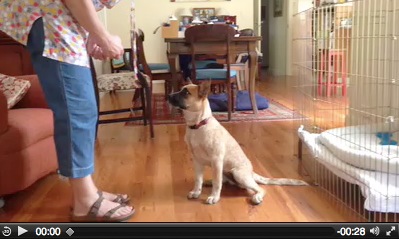
From an early age I wanted Wilbur to meet dogs of all shapes, sizes and disposition.


We socialised with steady mature dogs whose behaviour I wanted Wilbur to model. The older dogs would gently correct Wilbur if he got too big for his boots. A quick snap or bark is all that should be needed. If the pup doesn’t take notice try and interrupt the behaviour before the other dog has to react.
I avoided bouncy, boisterous dogs who encouraged Wilbur to wrestle or chase them. Being a working cattle dog I didn’t want to reinforce chasing or nipping behaviours. Puppies are cute and funny but their play can get overwhelming quite quickly especially when they play uninterrupted for extended periods. I like to interrupt play sessions every couple of minutes. Call your pup over do sit and drop then reward with another play session or treat.
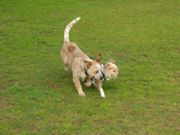
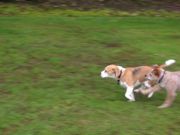
Millie and Mia were small confident dogs, happy to tolerate Wilbur as he tagged along. Wilbur was growing quickly, I wanted him to respect all the dogs no matter their size
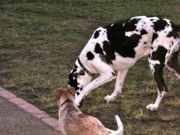
Wilbur barked at him several times as he tried to work him out. He was more curious than scared and built his confidence quickly by just hanging around Rocco.
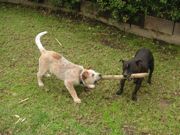
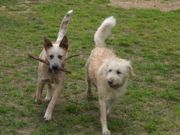
Carrying a stick in his mouth when playing reduced the temptation to nip.
Please don’t throw sticks for your pup, they can go through their mouth.
One dog I walk had a boil on her neck and when the vet operated he found a splinter from a stick that entered through the mouth. She was very lucky that it hadn’t created more problems.
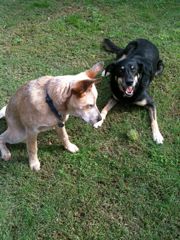
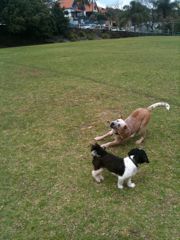
On the right is a good example of a Play Bow where Wilbur is saying come play with me Gomez. “Pleeasse I am no threat to you I just want you to chase me”.
Learning to swim
Wilbur loves the water but didn’t know how to swim. He hadn’t got the hang of dog paddling, he sank instead.
I got him used to fetching sticks in the shallow water and kept throwing them backwards and forwards. Gradually, I increased the depth of water as his confidence increased.



The beach where I taught Wilbur to swim had slight undulations on the sandy bottom, as he moved further into the water he intermittently went out of his depth and quickly back into a shallow, this developed into a swimming motion that became his dog paddle style.
It is important not to rush the pup or throwing them in the deep end as this can scare them from being in the water.
Once he built his confidence,he started going into deeper water and now swims with me and loves surfing.
When visiting a park with a young dog, I make it a rule to walk straight past the entrance, away from any posts and trees where other dogs are likely to have going to the toilet or done their ‘Pee-mails’. Open areas are less likely to have dog poo littering the area and also they are easier to spot than around trees and posts.
The big snip
After Wilbur’s neutering operation he was licking his stitches and so had to wear an Elizabethan Collar.


Putting on an Elizabethan Collar- Dogs find these devices pretty strange. To put it on I would simply hold a treat in my hand and place my arm through the collar. As Wilbur tried to get the treat I would draw my arm back and his head easily followed the treat until his head was through the collar. Then I rewarded him with the treat and secured the E-collar with his usual collar.
He only needed to wear the collar for a couple of days till the stitches stopped itching.
